|
Whoa, some of my old German uniforms posts got salvaged. Thanks! If anyone has any more questions or wants photos, let me know. SeanBeansShako posted:Doesn't Cessna also have a time share on a Soviet tank for reinacment purposes? Yes, although I haven't spent time on it since Covid. Cessna fucked around with this message at 02:54 on Dec 7, 2020 |
|
|
|

|
| # ¿ May 21, 2024 16:35 |
|
Grimnarsson posted:Also about those sitty German uniforms, would the paratrooper helmet been better than the regular steel helmet? Or was that needlessly complicated too? Better? It was, roughly speaking, the same helmet in terms of performance. It's pretty much the same metal, just as thick. It's recognizably different in that it doesn't have the distinctive "naughty German helmet" profile; it does not have the extended edge/cover that goes over the top of the ears/back of the neck:  This is because early attempts at wearing "naughty German" helmets when jumping out of planes went badly. The air would catch that edge and push the helmet forcefully over into the wearer's face, which is not a good thing when you're falling towards the earth. There's also a more complex chin strap, also designed to keep the helmet from moving around when you're jumping out of a plane. The liner is also quite different, as shown in the original post I made. It's more like an old school motorcycle crash helmet, which makes sense given it's roots as a daredevil's stunt helmet. The seams are, of course, hand stitched.  By roughly 1944 they stopped getting the distinctive helmets and were given regular "naughty German" helmets instead. Here's a photo from Normandy; it's also interesting for the fact that they mostly have "plain" (uncamouflaged) smocks: 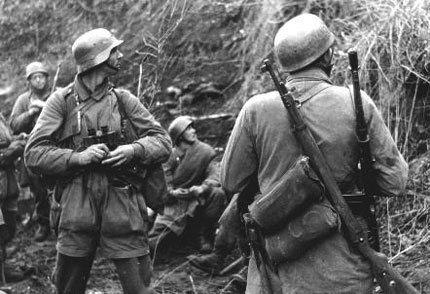 As it is, the vast majority of paratrooper helmets out there are reproductions "aged" to look like the real thing. For an article on how to forge one, here's a link.
|
|
|
|
Edgar Allen Ho posted:Did the flaring bits on the classic stalhelm serve a practical purpose that the FJ helmet suffered from losing? Sure, as stated it provided a bit more protection to your neck, especially when lying down. The US's post 1982 kevlar helmets use broadly the same pattern for this reason, and there was some hesitance to adopt that helmet because it looked so much like the "naughty German" helmet.  The Germans really bought into the helmet as an icon of their military. "Der Stahlhelm" was the name of a right-wing veteran's group in the inter-war years. The helmet's profile was also used on awards:  (That's the WWI version. The WWII version had a swastika.) It was also the tactical symbol of the Grossdeutschland Division, used on vehicles:  To get REALLY pedantic, the replacement helmet eventually adopted by the DDR was designed in 1942, specifically to make production simpler. (This wasn't the M1945, that's a different deal, a mid-war M42 (itself a simplified M36 (no rolled edges) that omitted the little rivet/vents in the sides for ease of manufacture (although this might not have been an "official" variant, just shoddy manufacturing).) But because the stahlhelm was so iconic, Hitler personally blocked it's manufacture.
|
|
|
|
Cyrano4747 posted:edit: realized I need to clarify that that dude's an East German soldier. They, uh, reused a lot of the old Wehrmacht look, especially early on. It is downright shocking how much the DDR didn't alter the "look" of their military. I mean, look at that guy. Collar litzen (the bars) with waffenfarbe (branch of service colors, white = infantry). Feldgrau uniform. Shoulder boards with identical insignia to the Wehrmacht. That's an adoption of the old Wehrmacht uniform with the same incremental updates that they would have had if the Nazis hadn't lost.
|
|
|
|
SeanBeansShako posted:I assume some of the early DDR uniform stuff was done for cost reasons.  Feldgrau uniform. Identical rank insignia. Similar shooter's lanyard. Similar collar litzen. Identical pockets. Similar cut. Similar pattern "cuff title." That's a Wehrmacht uniform with updates. They slightly redesigned the uniforms, then issued hundreds of thousands of them. Since they're redesigning them anyway, why not make them look a bit less Wehrmacht-y? I doubt they saved any money there.
|
|
|
|
Here's a Wehrmacht M40 feldbluse for comparison:
|
|
|
|
Ataxerxes posted:Yeah, Sweden sorta went the other side roung. The masters thesis of a dear friend (and his upcoming PhD thesis) is about the transformation of the Swedish army from the semi-feudal "nobility is supposed to turn up with their own troops and some infantry" of mid 1550's to the beginning of the reign of Gustavus Adoplhus. This is the era of The Northern Wars/The Deluge, right?
|
|
|
|
Ataxerxes posted:Nope, 1550's to 1610 is before either. 1650's for the Deluge, from then onwards until 1700-21 for the Great Northern War that broke the Swedish empire. The largest achievement of Gustavus Adolphus was reorganizing his realm so that he could tax and conscript effectively, he died in Luetzen but he increased the size of his realm and it ended up in a stronger position after 30yw than it started in. Ah, cool, thanks.
|
|
|
|
Milo and POTUS posted:What were the allies using that avoided these problems, especially the noise complaint. Seems like the days before plastic everything Let's take a close look at my back, wearing German gear circa 1942, with the full a-frame march order:  Look at all of that bare metal. Helmet, mess tin (kochgeschirr), gas mask canister, and the little drinking cup on the top of the canteen. All of that just rattles and clanks together. Here's gear from ca. 1944. I'm the guy on the right, in the "tan/water" smock.  Things are a bit more covered, but not much. The gas mask can and canteen cup are still completely bare. But, worse, the gear isn't really secured well. Many items are made from leather (the belt, the y-straps, all sorts of loops for securing gear) or held on by little leather straps with small buckles. It's like a belt; it's often either too tight or too loose, and either way the gear is going to clatter and shift around. It all feels very primitive and lashed together. In comparison, here's a WWII US GI's gear.  Note that there's almost no bare metal beyond the helmet and small stuff like snaps. Everything is in it's own little padded pouch. The webbing is canvas. Things hook onto the belt directly instead of being suspended by a strap with a buckle. It's a much better setup. Just look, to get even finer, at a mess kit. An American mess kit is metal, sure, but it comes with a pouch that keeps it from banging around:  A German mess kit is bare metal. Sometimes it would get strapped to a pack, or hung off a bread-bag, but either way it was exposed and could clatter around: 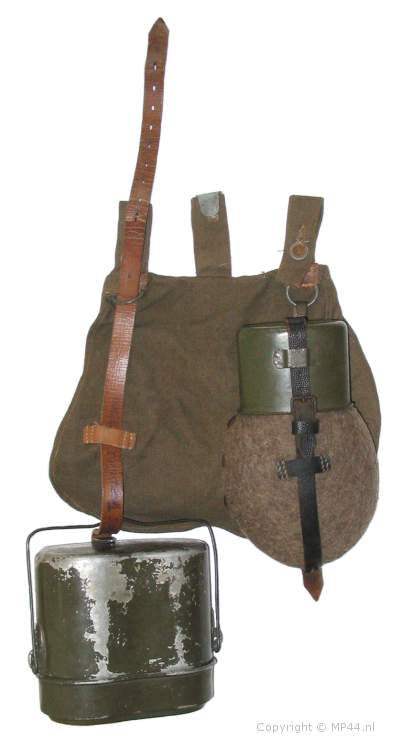 Look at that German canteen too - it's got a thin felt case and an exposed metal cup. The US equivalent had a bigger cup, but that was stored on the base of the canteen, inside a padded pouch that, again, clipped to a belt directly. It doesn't bang around when you move:  It's not just that the Allied stuff was materially rich, with special pouches; the Germans had those for things like their e-tool, ammo, etc. But the German stuff was poorly laid out, poorly secured, and often made from leather (whose quality declined as the war went on). It just wasn't as well developed. Now, yes, if they're making some sort of deliberate attack they could leave their stuff - the a-frame, the mess kit, etc - somewhere so it doesn't bounce around. But when your choice is whether or not to leave such basic items as a canteen home, your gear is bad. The smell I mentioned is from all of that wool. It has a really distinctive smell when it gets wet, sort of like wet dog.
|
|
|
|
TooMuchAbstraction posted:Thanks for those photos, they're really interesting. I've got all kinds of crap if you want more photos of gear. TooMuchAbstraction posted:Why does the canteen come with a cup? Can't you just drink straight from the canteen? Or is the cup for if you need to boil the water or something? A canteen cup is VERY useful. You can, as you say, put something in it and heat it, like coffee. You can also eat from it (soup, stew, etc), use it for water for shaving/washing, that sort of thing. (Germans would probably use a mess tin for these tasks if they were available, but they weren't always on hand.) Edit to clarify: The US canteen had a larger cup, that the canteen sat in inside the cover. They also had a mess tin that was more like a divided dish. The Germans had a small canteen cup and a small mess tin, pictured above.)
|
|
|
|
Schadenboner posted:...sir, this is the Milhist Thread. Well, what do you want to see?
|
|
|
|
Schadenboner posted:What's the deal with the little trashcan the nazis all carried at the bottom? (Hope phone pics are okay.) That's a gas mask canister. And since I mentioned the canteen, here's one of those:  It's surprisingly sturdy, made from metal that is almost as thick as a helmet. It's carried by two canvas/web straps that hook onto the main belt or sling over the shoulder. There's a catch/clamp that holds it closed, and it is completely air/water tight; as a result soldiers used them to carry their cigarettes. There's an elaborate little compartment inside the lid for spare lenses:   Here's the mask, with reproduction matches and cigarette pack. The matches are from the "club" in one of the big reenactment events. I used to reenact as a "Chain dog" (military police) because I worked/volunteered to help the event organizers. Hassling people at the club was part of the event.  At the bottom of the canister is a spring that holds down a piece of felted cloth used to clean the lenses:  Here's the canteen cup, with the complex leather strap and hook used to hang it from the d-ring on the bread-bag: 
|
|
|
|
zoux posted:How does WWII reenacting work? I can gather how musket-era military reenactments go, bunch of dudes stand in lines and shoot black powder at one another, but how do you account for all the tanks and air support and MG emplacements and squad-sized maneuver and such We have tanks, halftracks, mgs, etc:  (That's me, again.)  Sometimes we get a bit a bit dramatic for public events. These were done for a student filmmaker from a nearby university:     We've also done airshows with "strafing" planes for air support.
|
|
|
|
Schadenboner posted:Oooh, show your gorget! I lent that to a friend, I won't have it back until post-Covid, but I'll post pics then.
|
|
|
|
SerthVarnee posted:Was there any noticeable difference in the weight of the gear for your average infantryman across the various nations? I've worn modern stuff when I was in the service, plus WWII German and Soviet stuff. There's no single answer here, because you'll carry different stuff depending on the situation and mission. SerthVarnee posted:If there was, did they still manage to bring supplies and equipment to last a similar number of hours/days? Again, situation dependent. If you're on a long march out of contact with the enemy you'll carry different (probably more) gear than you would on a patrol. SerthVarnee posted:Were they reliant on different locally sourced resources? Not really, but they'd loot stuff when you could. There are plenty of photos of, say, German soldiers stealing cows, chickens, bottles of wine, that sort of thing. SerthVarnee posted:How long could a soldier expect to be without a piece of (not firearm) gear before getting an official replacement? There's no single answer here, it entirely depends on the situation.
|
|
|
|
SerthVarnee posted:How was ammo distributed among say a squad on regular patrol, was there special bags for one or more of the soldiers to carry extra ammo for the whole squad? For the Germans? In tl;dr terms, the German rifle squad is a microcosm of fascism. You have a leader. That leader has an immediate subordinate with a weapon that he, the leader, directs to kill enemies. Everyone else follows along to support that leader and the thug with the weapon. The leader leads the squad. In a fight he places up his machinegun and gets it to work, directing its fire. Then he tells the riflemen what to do to keep the fight going and the machinegun working. So, with that in mind, exact organization varied over the course of the war, but here's the basic starting point: 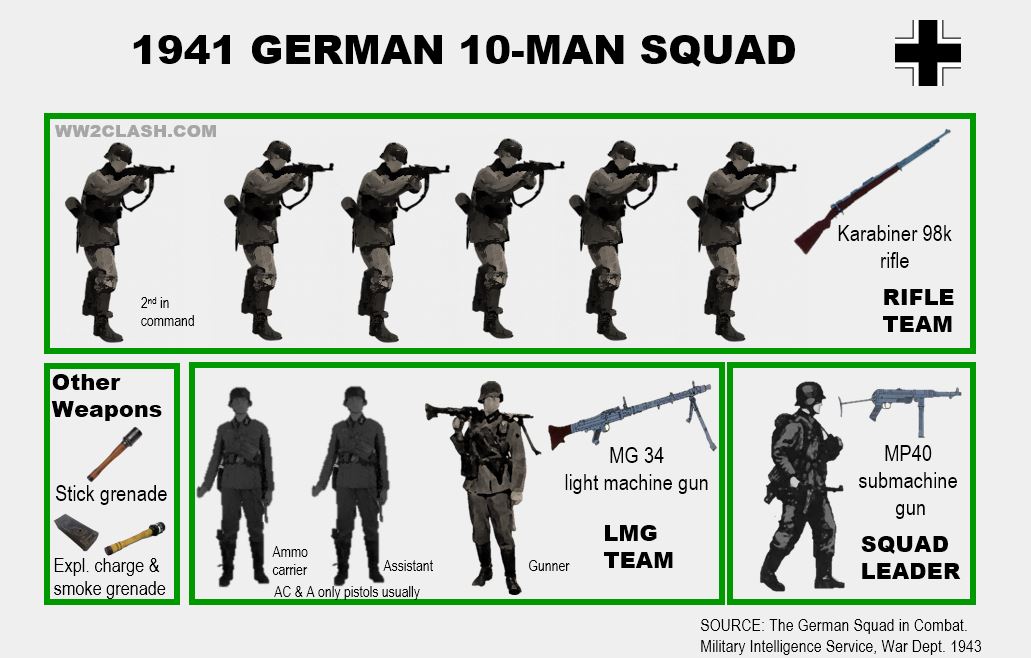 So - you've got the squad leader, with a submachine gun. Next, you've got the machinegun section. That's the immediate subordinate with a weapon. That's what does most of the actual killing. It's a gunner and two assistants, whose job is to feed the gun. Finally, you have a bunch of riflemen. Their job is to do what it takes to help the machinegun kill people. They might dig in around the machinegun to protect it from Soviet troops with pointy bayonets, they might go out and try to flank the enemy like a hunting dog flushing out birds - whatever it takes. Each of those riflemen has two ammo pouches on his belt; the hooks on the shoulder/y-straps connect to rings on the back. Each pouch is divided into three pockets. Each pocket holds two 5-round clips (yes, clips). So, 60 bullets total for each riflemen, although they'd certainly pack more in their pockets if they could. 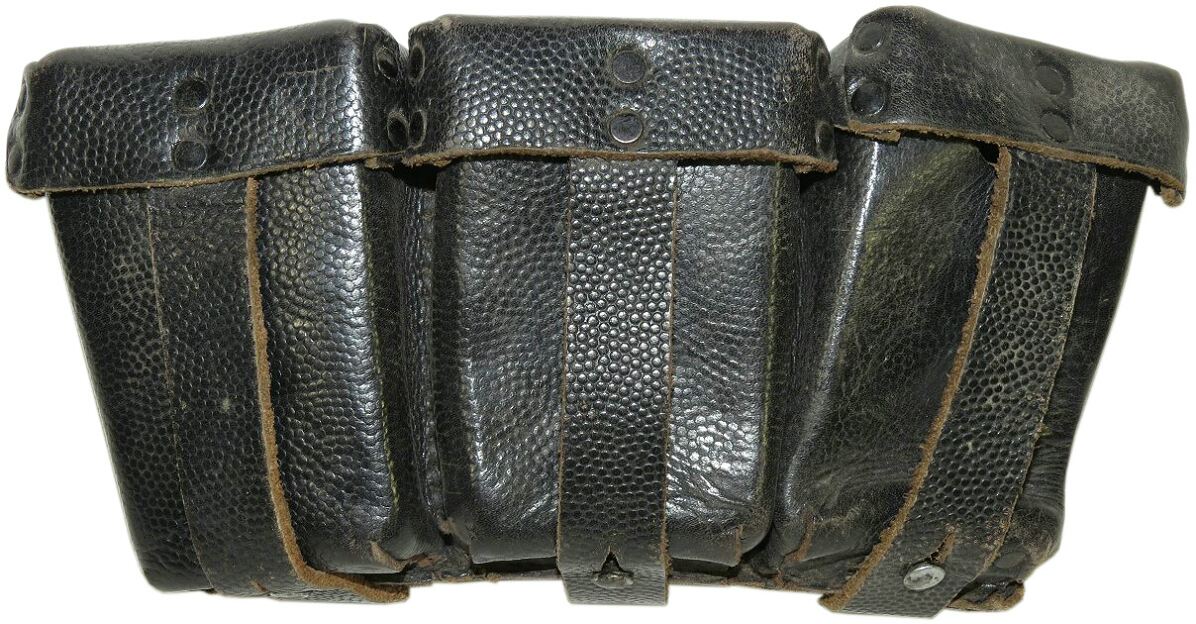 The machinegun has ammo in ammo boxes, drums with a belt inside, or loose belts. On paper the machine gunner carried a 50-round belt drum. The assistant machine gunner carried 4 additional 50-round belt drums. And, like I said, it is the job of the riflemen to support that machinegun, so odds are that some or all of them will also be carrying a 300-round box or more of machinegun ammo - again, their job is to support that machinegun: Cessna fucked around with this message at 06:07 on Dec 11, 2020 |
|
|
|
SerthVarnee posted:Lets say heading train unloading point A to expected headquarters sorting area before shipping to actual front line. The poo poo you carry with you from the garrison to the duty assignment. Not the actual mission tweaked loadout, just getting dude from rear to here with his own gear. For the Germans you're looking at roughly what I have in this pic:  That's about 45 pounds of gear. A-frame with zeltbahn (shelter section/half), tent poles, a little bag with spare underwear, socks, and a sweater. On the belt you've got an e-tool, a bayonet, a canteen, ammo pouches, a messkit, and a breadbag. The "breadbag" is a sort of catch-all, it's sort of like a purse that carries your stuff. Sausages wrapped in wax paper, another pair of socks, your amphetamine-saturated chocolate bars, etc. Edit: You also could add a "tournister," a backpack with spare uniforms, for another 10-20 pounds. SerthVarnee posted:We'll go with the same situation, rear line transfer carrying your own general gear during transit. Any food or drink (iron rations or what have you) carried along or is that strictly controlled and distributed at specific points along the way? Still situation dependent, but broadly speaking you'd carry snacks in your breadbag like I mentioned above, plus you'd stop as often as practically possible for a meal at a field kitchen (gulashkanone): 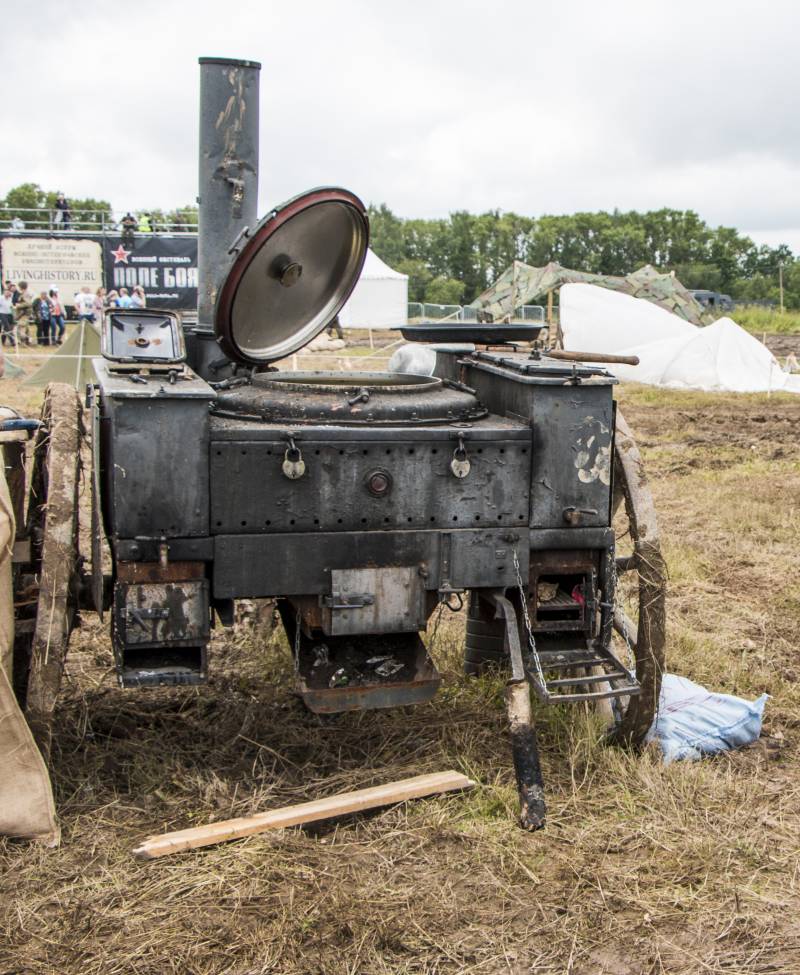 It's pretty much a stove on wheels. The Germans were big on stews (goulash). Anecdotally the Germans were jealous of the American pre-packed rations (K-rations, etc) for their convenience, but the American GIs envied the fact that when the Germans got a meal it was hot and hearty. As an aside, my reenactment group had one of these (gulachekanone) and cooked on it. SerthVarnee posted:Hans manages to gently caress up his gas mask canister through liberal application of alcohol and some applied physics. This happens in France sometime around....lets say august 41. Following a fairly colorful conversation with the nearest NCO, would he just be poo poo out of luck or would he "find" a replacement? Or would the army send him another one with lots of flowery words about looking after your gear in a more proper german manner in the future. I don't have exact figures, but I can tell you that each German soldier had a "soldbuch," a little passport sized book often called a "paybook." There are pages inside the book are pages where every piece of gear, down to individual pairs of socks, it tracked and itemized. Over the years I've collected old "soldbuchs" from ebay.de. I thumbed through a few of them just now and found one out of eight where the owner got a new gas mask can. Take that entirely anecdotal and incomplete evidence as you will. SerthVarnee posted:Lets say the same thing happens to an american infantryman sometime in august 44. same result? (less german mannered gear care lecture I presume) The GIs famously ditched their gas masks (there's a Willie and Joe cartoon about this). The Germans didn't, supposedly because they took the prospect of chemical warfare more seriously as a result of their more extensive experiences in the trenches of WWI (Hitler was gassed himself). But I can confidently state that American soldiers had much better access to replacement gear than pretty much any other army in WWII. Cessna fucked around with this message at 06:09 on Dec 11, 2020 |
|
|
|
SerthVarnee posted:So in a prolonged firefight who would be saddled with the job of getting more ammo? By prolonged i mean a fight where the leader is reasonably sure that the first half of their mg ammo is long gone and it doesn't look like the fight is over when the other half runs out. Remember those riflemen? SerthVarnee posted:Also, at what point is squad considered officially combat impaired or combat ineffective? When there is a soviet flag flying over the reichstag. That is to say, they really didn't have the option to say "okay, we're down X men, we're done for the day." If there was a lull between battles rifle squads (and up) might be reconstituted into re-built formations, but the Germans were a bit more hesitant to do this than other armies. In contrast, the Soviets were much more willing to do this.
|
|
|
|
SerthVarnee posted:Okay so I got this mental image of the army being a fuckton of running to get to where you have to wait for the truck that takes you to the place that gets your gear dirty and then takes you back so you can clean it all. Some shooting may also be involved here and there. Are we talking about modern stuff, like a US soldier in Iraq? For Germans in WWII it was either marching on dirt roads or riding in trains. Trucks were comparatively rare and only in some units. Most of their soldiers just marched. SerthVarnee posted:Did they bring their own maintenance/cleaning material or did they go draw that from the quartermaster when there were deployed to a post? I'll let the WWI people handle that part of the question. For WWII Germans - well, early on in the war there are plenty of photos of them in barracks and they're relatively clean:  Most of their time, from what I can piece together, was spent cleaning, doing exercise, marching, having inspections, listening to Wagner, and attending endless lectures on how to be more of a racist piece of human trash. At the front, well, you're fighting. If you get a chance you wipe off the dirt, then go back to fighting.
|
|
|
|
SerthVarnee posted:Good question, has the loadout changed between the two scenarios? does one of the two examples make the soldier carry his own gear-cleaning toothbrush and essential oils? A modern soldier is MUCH better equipped. Admittedly my personal experience is outdated, I got out in the 90s. And I was an armor guy, so I wasn't working under the constraints of an infantry soldier. (Weight wasn't a consideration, so we'd carry all kinds of crap, see below.) In tl;dr terms, modern stuff weighs less and takes up less space, so you can carry more/different stuff. SerthVarnee posted:You said yourself that maintenance was the name of the game (when we were arguing about crewless tanks). I am trying to figure out how many of the maintenance supplies were carried along by the troops and how they were expected to replenish those supplies. This is sort of an apples and oranges thing if you're comparing infantry to armor. For infantry, weight is crucial. On a patrol you won't carry anything if you can help it. You carry the essentials. Think in terms of ammo, water, and maybe a spare pair of socks. For armor, you carry whatever you can cram in. Every vehicle has a full tool box. You also have what we called "OVM gear," (Onboard Vehicle Maintenance). Picks and shovels, crowbars, boathooks, an axe, ropes, tow cables, tow shackles, stuff for the suspension, all kinds of stuff. Plus every vehicle has "unofficial" stuff crammed in wherever it will fit; wire brushes and rags, cleaning supplies, spare 9/16" bolts, buckets, you name it. And you might carry spares, like extra road wheels. Plus crates of food, gallons of water and spare oil, whatever you can pack in. And ammo, of course. The idea of not bringing something like spare/clean uniforms or food is anathema. Seriously, there is no comparison. With zero exaggeration and from personal experience: For an infantryman, luxury is a clean pair of socks and underwear. For armor, luxury is a cooking stove, a cooler full of ice and drinks, a lawn chair, a section of astroturf, a beach umbrella, and a radio wired into the batteries. SerthVarnee posted:I remember reading a book on the first world war where a german sailor bitched about being unable to get the stuff he needed to maintain and repair his uniform (he was stationed on one of german high seas warships parked in harbor for almost the entire war). What really pissed him off was the fact that he was to get his materials from the ship's stores, but there weren't any materials to be had. When he was found a fault during inspection for having poorly maintained uniform, he tried to argue that he was not supplied with any materials to do the maintenance and was told: "poor excuse! Do better!" WWI Germany was starving due to the naval blockade. SerthVarnee posted:So a sailor gets his stuff from the ship. The infantry gets their stuff from the....quartermaster back in garrison? sketchy looking dude in a back alley somewhere near Lodz? squad leader dressed up like Nazi Santa? nearest non-bombed out shop? Does replacement rags for the oiling and lubing and cleansing of the empero......Fuhrer's god given rifle go in the sold book? Stuff, when available, would come through the army's supply system or, for the Wehrmacht, looted from the locals. Cessna fucked around with this message at 23:24 on Dec 10, 2020 |
|
|
|
Nessus posted:I think the only fully motorized army was the USA. They had some horses but not, like, for hauling supplies as a primary mover. The UK as well. If anything, they hopped on the "all motorized/no horses" bandwagon a bit earlier than the USA.
|
|
|
|
Xiahou Dun posted:Why are you dodging this question, Cessna. Too few!!
|
|
|
|
Weka posted:But you repeat yourself. 
|
|
|
|
Nebakenezzer posted:I thought the Panther had good ground pressure, at least, so it surprises me it wasn't terribly good in mud. Was it a traction problem? The big problem with the Panther (and Tiger, and a other vehicles with a similar suspension) was that the road wheels were inter-leaved:  Mud - or gravel, or ice - would build up and jam in-between the road wheels. Cessna fucked around with this message at 17:08 on Dec 14, 2020 |
|
|
|
LingcodKilla posted:However the hobby is rife with actual nazis and I donít care to take part in it anymore. Same here. (I still collect Soviet stuff, but I haven't been to an event since 2012. And post 2016? No drat way.)
|
|
|
|
LingcodKilla posted:I just wonít do anything with German units. If you think it canít be that bad you gonna be sorely disappointed like I was after a few years. In my experience German groups are split between: (A) People who are big History nerds who just want to get into things and don't care who they dress like. (B) People who are into German gear because they built too many Panzer models when they were kids. (C) Assholes who want a Fourth Reich. I was in group A, and in retrospect that was too much. And the fact that there's too much (that is, any) of B or C just completely ruins it.
|
|
|
|
Chamale posted:I'm automatically leery of anyone who collects more Nazi memorabilia than other countries of WWII. A reenactor with an American, Russian, and German uniform is dedicated. A reenactor with a Wehrmacht uniform, an SS uniform, and no others is a neo-Nazi until proven otherwise. Soviet reenacting should get a LOT more attention. It's so much cheaper! Their stuff is readily available and costs about 1/2 to 1/3 of it's German equivalent on a piece-by-piece basis, and you need less of it!
|
|
|
|
Nenonen posted:Suggestion if you're poor as dirt but want to re-enact Nazis: There is a Volkssturm group that goes to big events on the East Coast that does it right. You must be over 50 to join. They're absolutely meticulous as far as historical detail. For example, civilian period-appropriate clothing is required, but it can't be NEW clothing - it has to be worn 1940s vintage and appropriate clothing, preferably with subtly sewn repairs or a patches or the like. They also have a rule for the maximum number of "military" items per event - so if it is "three" you might bring a rifle, armband*, and greatcoat, everything else must be civilian. They also have good "rules of engagement." Think of things like "only bring five blanks for the whole event" or "shoot a couple of times if you like, but surrender at the first plausible opportunity (unless you're against the Russians)" or "if possible don't bring enough food to events" - and "remember at all times that you'd rather be home." This is the sort of reenacting I like, because it's a direct "gently caress off" to the assholes who want to think they're uber-elite SS stormtroopers. If I ever do it again I'll look up this group. * Volkssturm armband: 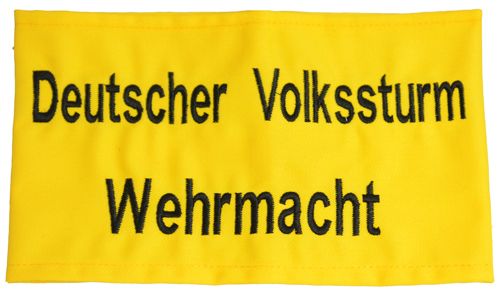 
|
|
|
|
Bundesarchiv.de, search by year. Link. On the top, "Jahre von" and "Jahre bis" are the start/end years of the search.
|
|
|
|
Nebakenezzer posted:There were a few other random examples of this having to do with rifle variants and pistols and I think a few light mortar designs, but the FG42 is the most famous example and the one I remember the best. A couple of points about Fallschirmjager (German paratrooper) uniforms always stick out to me. (Yes, there should be an umlaut over the "a.") Fallschirmjagers used a different tactical model than the Allies. In tl;dr terms, the Allies jumped out high over the target. This gave them more time to open their 'chute and made it so that they could carry more of their own gear in a bag. This made them more exposed, which led to them jumping at night. In contrast the Germans dropped in broad daylight very low. They couldn't risk having anything on their person that would snag on anything, so they got all kinds of special gear, stuff that was more suited to a Rocketman-like daredevil than a soldier. So: 1. They had a specially made "jump smock." The initial models had a problem:  They had a zipper, but no other sort of waist closure or opening. As a result, if they wanted to take a crap, they had to take off the entire smock - which meant that they had to take off ALL of their gear as well. Here's a group of them in Crete. Note that they aren't wearing pants. Yes, it's hot, but in the interest of expediency they've just dropped their pants entirely so as to make crapping possible. It's smock, gear, and nothing else: 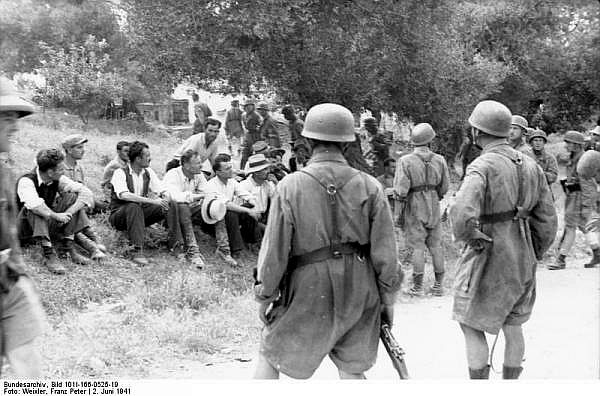 2. They had specially made boots for jumping out of planes. 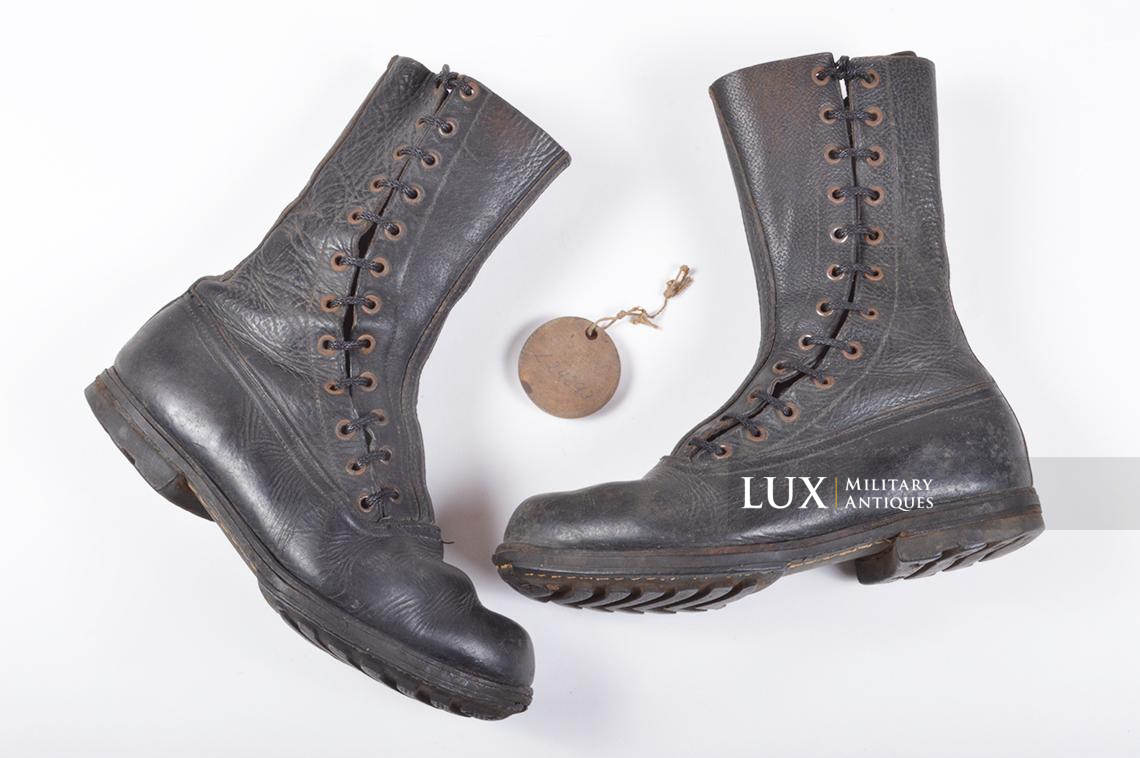 Note that the laces are on the side, supposedly to help avoid snagging on parachute shrouds. What gets me is the little groove on the heel - it's a bit hard to see, but there's a distinct groove cut where the heel meets the sole. The soles were rubber, a rarity for Germans, who usually used leather. This is because they were issued special cloth bootie covers that would slip over the sole of the boot. Why? So that they wouldn't track mud into Goering's precious airplanes. Even in 1944, when German paratrooping had been off the table for years and the Luftwaffe was a wreck, their cobblers still specially made those grooves in their boots for the special cloth covers.
|
|
|
|
Cyrano4747 posted:Also I donít know how true this is but Iíve heard that part of the reason for that early grip was to fit the gun in the drop tubes the luftwaffe used for their gear. Right, like I said, they didn't jump with their gear, just the stuff they wore (including specially made knee pads) and a pistol. They'd hit the ground, then run and try to find the canister that contained their rifles. What, the canister blew away and landed somewhere else? Oops. 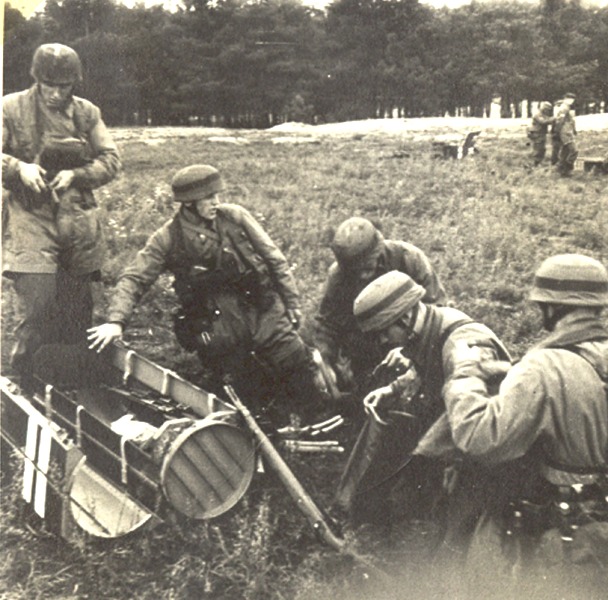 
|
|
|
|
KYOON GRIFFEY JR posted:if you dont want to write the umlaut just write ae Or I could write it in Word and copy/paste, but gently caress Nazis.
|
|
|
|
Nebakenezzer posted:The Luftwaffe also attempted a paradrop during the Battle of the Bulge which was a disaster, partially because of this "drop poo poo seperately" thing. The reason why poo poo was dropped separately was that the Ju 52 was so tiny relative to even the C-47 that getting the paratroops and their gear just didn't fit. No, like I said, it was doctrine. Allied paratroopers dropped high, at night, and carried their stuff. German paratroopers dropped low, in daylight, and didn't carry their stuff. Edit: Here's a famous photo of the drop on Crete. You can see how low those planes are:  Cessna fucked around with this message at 17:08 on Dec 15, 2020 |
|
|
|
Nebakenezzer posted:Was this docterine thing because of the Ju 52 being small, or was their doctrine always about dropping into defended airspace to take strong points? Exactly that. German doctrine was to aggressively jump right on top of the objective, whether using gliders or parachutes. (Think of the attack on Eben Emael for an example.) Allied doctrine was was to drop, often at night, then form up, then go for objectives. (Think D-Day.) That said, yes, it seems odd that "dropping aggressively right on top of the objectives" was combined with "drop without weapons." This was because they wanted to minimize the time spent exposed to anti-aircraft (and parachutist) fire as those objectives would inevitably be defended. So, again, they'd come in very low, land, then run to pick up their stuff and attack immediately. Whether or not this was a batter plan is up to debate.
|
|
|
|
Grumio posted:If I'm wrong about this, please be gentle, Cessna No, this is entirely correct. Because the Germans dropped relatively low they went with a design that was simpler and opened faster, but wasn't as controllable. Less control wasn't seen as a drawback because they were already so low that they'd scatter less.
|
|
|
|
Acebuckeye13 posted:Worth noting that D-Day itself was such a disaster for the airborne troops it ended the night drops. Paratroopers ended up scattered over so wide of an area that for many it became functionally impossible to rally, and commanders were forced to make ad-hoc units out of whoever was in the immediate area at the time. While the overall operation was obviously a success, the challenges and risks imposed by dropping at night were made so abundantly clear that both Market Garden and Varsity, the two last big Allied Airborne operations of the war, were conducted during broad daylightóAnd of course, Market Garden would have its own cavalcade of issues. Oh, absolutely. And, as stated, Crete (which used the German doctrine) was an absolute poo poo-show as well. I don't think there's a really good way to drop a big unit with parachutes in WWII; you just do it if the reward outweighs the losses.
|
|
|
|
ChubbyChecker posted:The invasion had a naval part too. It's also worth remembering that a good number of the troops brought in by air weren't paratroopers; the 5th Gebirgsjager were mountain troops flown in by planes.
|
|
|
|
KYOON GRIFFEY JR posted:if I recall correctly there's a giant statue of a shoe in Tirkit that the town put up in his honor Alas, it was taken down. 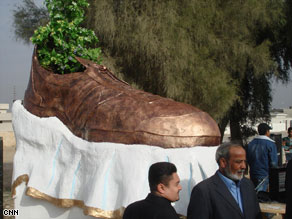
|
|
|
|
C.f., Amphibious assaults.
|
|
|
|

|
| # ¿ May 21, 2024 16:35 |
|
Platystemon posted:The use of gliders in WWII is so weird form a modern perspective. When you don't have helicopters but still want to move things that are a bit heavy they look a lot better.
|
|
|






